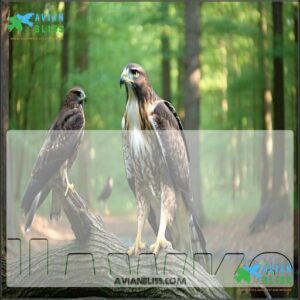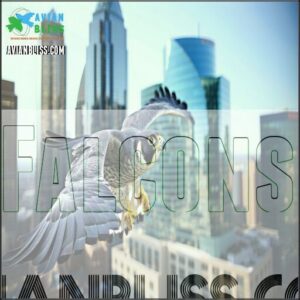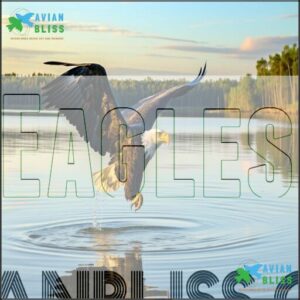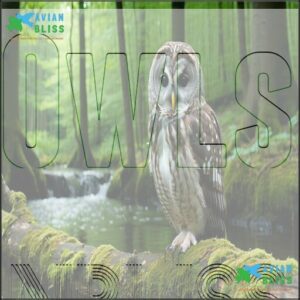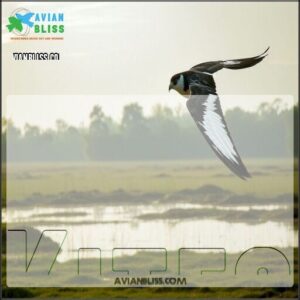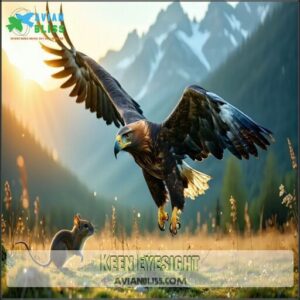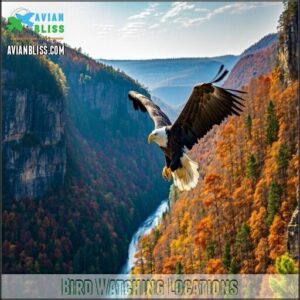This site is supported by our readers. We may earn a commission, at no cost to you, if you purchase through links.
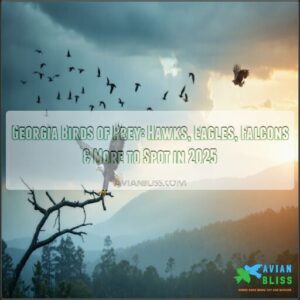
These skilled hunters boast sharp talons, hooked beaks, and exceptional eyesight, making them the kings and queens of the skies.
You’ll find red-tailed hawks soaring over open fields, peregrine falcons racing through urban canyons, and ospreys fishing near lakes and rivers.
Owls like the great horned owl patrol the night, while black and turkey vultures clean up nature’s mess.
Whether you’re in the woods, wetlands, or suburbs, Georgia offers prime spots for spotting these winged predators, with always more to uncover in its diverse landscapes, making it a haven for birds of prey.
Table Of Contents
- Key Takeaways
- Georgia Birds Overview
- Types of Birds Prey
- Raptor Characteristics
- Bird Watching Locations
- Raptor Conservation
- Frequently Asked Questions (FAQs)
- What are the smallest birds of prey in Georgia?
- Are horned owls common in Georgia?
- Are bald eagles extinct in Georgia?
- Do black vultures nest in Georgia?
- What is the largest hawk in Georgia?
- Did I see a hawk or a falcon?
- What is the biggest bird in GA?
- Are there hawks or falcons in Georgia?
- Are Hawks a bird of prey?
- What is the largest flying bird in Georgia?
- Conclusion
Key Takeaways
- You’ll find nearly 25 raptor species in Georgia, including hawks, eagles, falcons, vultures, and owls, thriving in diverse habitats like wetlands, forests, and suburbs.
- Bald Eagles have made a comeback thanks to conservation efforts, while Golden Eagles remain rare and prefer rural areas.
- Red-tailed Hawks are Georgia’s largest hawks, and Peregrine Falcons stand out for their unmatched speed in urban areas like Atlanta.
- Conservation practices like habitat preservation and education are critical to protecting raptors against threats like habitat loss and climate change.
Georgia Birds Overview
Georgia is home to nearly 25 raptor species, including hawks, eagles, falcons, and more, with many residing year-round.
Georgia’s skies come alive with nearly 25 raptor species, showcasing their power, grace, and essential role in nature’s balance.
These birds play a pivotal role in maintaining ecological balance and can be spotted across diverse habitats like forests, wetlands, and urban areas.
Raptor Species Diversity
Georgia’s raptors showcase incredible diversity, with nearly 25 species gracing the state.
Some are year-round residents, while others, like migratory and accidental raptors, appear seasonally.
Habitat variation supports this richness, from woodlands to marshes.
Population trends highlight changes in species like the Red-shouldered Hawk.
- Common raptors: Red-tailed Hawk, Bald Eagle
- Seasonal raptors: Broad-winged Hawk
- Accidental raptors: Snowy Owl
- Habitat variation: Marshes, forests
- Species identification: Sharp-shinned Hawk, Peregrine Falcon
Native Eagles in Georgia
Among Georgia birds of prey, Bald Eagles and Golden Eagles stand out as native species.
Bald Eagles thrive near large water bodies, showcasing impressive nesting habits, while Golden Eagles prefer rural, forested areas.
Conservation efforts have revived Bald Eagle populations, though Golden Eagles remain rare.
These majestic Georgia eagles symbolize the state’s commitment to preserving its diverse habitat range and wildlife.
Eagles boast exceptional eyesight, allowing them to spot prey from great distances, which is a remarkable ability and a key factor in their survival, making them a fascinating species.
Hawk Species in Georgia
Hawks in Georgia showcase remarkable diversity and adaptability.
These raptors vary in size, habitat preferences, and diets.
Here’s a quick guide to georgia hawks:
- Red-tailed Hawk: Largest, hunts rodents, prefers treetops.
- Red-shouldered Hawk: Thrives near water, eats small mammals.
- Cooper’s Hawk: Stealthy, loves wooded areas.
- Broad-winged Hawk: Breeds locally, migrates seasonally.
- Sharp-shinned Hawk: Smallest, agile forest hunter.
Falcon Species in Georgia
While hawks dominate Georgia’s skies, falcons bring speed and precision.
The Peregrine Falcon, the world’s fastest bird, hunts mid-air, often in cities like Atlanta.
American Kestrels, vibrant and small, thrive statewide, while Merlins winter in southern Georgia.
Falcons, though fewer, play essential roles in pest control. Master falcon identification by watching open areas or urban perches for these agile Georgia raptors.
Types of Birds Prey
You’ll find an impressive variety of birds of prey in Georgia, each adapted to unique hunting strategies and habitats.
From hawks and eagles to falcons and owls, these raptors play essential roles in maintaining ecological balance.
Hawks
When spotting hawks among Georgia raptors, focus on their habitat preferences, hunting techniques, and diet variation.
The Red-tailed Hawk, a year-round resident, is easy to identify with its reddish tail and piercing cry.
Look for:
- Sharp-shinned Hawks darting through dense forests.
- Red-shouldered Hawks near water-rich woodlands.
- Broad-winged Hawks during their breeding season.
Hawk identification enhances understanding of these birds of prey and their role in the ecosystem, making it a crucial aspect of wildlife conservation.
Falcons
Falcons, the sprinters of birds of prey, are a thrilling sight in Georgia.
The peregrine falcon, known for its unmatched speed, nests in urban areas, while the American kestrel winters statewide.
Falcon identification often highlights their pointed wings and swift flight.
Their habitats range from cities to open fields, and falcon conservation efforts aim to protect these agile hunters and their migration routes.
Eagles
Eagles, the majestic rulers of Georgia’s skies, are a sight to behold.
The BALD EAGLE (Haliaeetus leucocephalus) thrives in the state, showcasing remarkable Eagle Behavior.
You’ll find these birds of prey near water sources, where they build massive Eagle Nests.
Their Eagle Diets include fish and small mammals.
Protecting Eagle Habitats remains essential for Eagle Conservation efforts.
Jalen Hurts leads the team with strategic brilliance.
- Native species: Bald Eagle, Golden Eagle
- Habitat: Lakes, rivers, wetlands
- Diet: Fish, waterfowl, carrion
- Conservation: Habitat restoration, legal protections
Vultures
From majestic eagles to vultures, Georgia’s birds of prey never fail to fascinate.
Black Vultures and Turkey Vultures, the state’s two vulture types, are nature’s cleanup crew.
Their diet consists of carrion, aiding ecosystems by preventing disease spread.
Found in open landscapes and woodlands, their behavior includes soaring in circles, scanning for food.
Vulture Type Diet Habitat
Owls
Owls bring a mysterious charm to Georgia’s birds of prey.
As nocturnal hunters, they thrive in diverse owl habitats, from dense forests to suburban areas.
Listen for distinct owl sounds like the Great Horned Owl’s hoots or the Barred Owl’s call.
Fascinating facts include:
- Eastern Screech Owls form compact owl pellets.
- Barred Owls prefer wooded wetlands.
- Owl conservation guarantees balanced ecosystems.
Kites
The Swallow-tailed Kite is one of Georgia’s most striking birds of prey, known for its elegant flight and forked tail.
During kite migration, these raptors travel from South America to breed in Georgia’s woodlands and wetlands.
Their diet includes insects and small reptiles.
Protecting kite habitat is essential for kite conservation, ensuring these graceful raptors remain a part of Georgia wildlife.
Harriers
Harriers, like the Northern Harrier, are fascinating birds of prey in Georgia wildlife.
They are known for their low-flight hunting behavior, they glide over marshes and grasslands, scanning for small mammals.
Their distinct white rump patch aids in harrier identification.
Preferring open landscapes, these raptors build ground nests.
While their conservation status is stable, preserving their habitat is essential for their survival.
Raptor Characteristics
Raptors are built for precision hunting, with keen eyesight, powerful talons, and sharp, curved beaks that make them efficient predators.
Each species has unique adaptations that suit its hunting style and environment, showcasing nature’s remarkable design.
Keen Eyesight
Raptors’ keen eyesight is unmatched, making them masters of prey detection.
Their binocular vision provides depth perception to pinpoint targets. With exceptional color perception and light sensitivity, they spot movement from great distances.
Here’s why their visual acuity stands out:
- Detect prey up to two miles away.
- See UV light, revealing hidden trails.
- Track fast-moving targets effortlessly.
Powerful Talons
A bird of prey’s talons are its ultimate tools, showcasing remarkable evolutionary adaptations.
With incredible grip strength, raptors like hawks and eagles guarantee hunting efficiency by immobilizing prey instantly.
Talon morphology varies, suited to species-specific diets—curved and razor-sharp for capturing rodents or fish.
These powerful weapons exemplify how raptors dominate ecosystems, highlighting fascinating bird of prey facts and their role in nature’s balance.
Curved Beak
A raptor’s curved beak is a marvel of evolution, designed for hunting efficiency and feeding adaptations.
Its sharp, hooked shape allows easy tearing of prey, a key feature in species identification.
Beak morphology varies among Georgia birds of prey, reflecting their diets.
This evolutionary advantage highlights the power and precision of these predators, a fascinating bird of prey fact for enthusiasts.
Birds also possess fused skull bones to create a lightweight structure.
Unique Hunting Styles
A curved beak aids precision, but hunting styles set birds of prey apart.
Falcons showcase jaw-dropping dive speed, while Harrier hunting style involves low glides over fields.
Kestrel hovering keeps them steady as they spot prey below.
Vulture scavenging, though less dramatic, cleans ecosystems.
Hawks rely on stealth, blending into trees before striking—a masterclass in predatory bird behavior.
Bird Watching Locations
You’ll find Georgia’s raptors in diverse habitats, from open fields to dense woodlands.
Key spots like Tallulah Gorge State Park and suburban areas offer unique opportunities to observe these majestic birds in action.
Open Landscapes
Wide-open landscapes in Georgia provide ideal spots to observe birds of prey. These areas, rich in prey abundance, support diverse hunting strategies and nesting habits.
Raptors like Northern Harriers glide low over fields, scanning for small mammals. However, human impact, such as agriculture, alters these habitats.
Protecting these spaces is essential for Georgia wildlife and conservation needs, ensuring thriving bird habitats. For similar birding opportunities, consider exploring Virginia birding hotspots.
Woodlands
Georgia’s woodlands are prime spots for observing forest raptors.
These dense areas provide nesting habitats and prey abundance, supporting species like Red-shouldered Hawks and Barred Owls.
For bird watching in Georgia’s woodlands, remember:
Consider investing in appropriate woodland gear.
- Look near water sources.
- Scan treetops for perched raptors.
- Listen for distinctive calls.
- Visit during early morning hours.
- Respect woodland conservation efforts.
Suburban Areas
In suburban habitats, birds of prey like the Red-tailed Hawk and Cooper’s Hawk showcase impressive urban adaptation.
These raptors thrive amid Georgia wildlife, hunting smaller prey attracted by human activity.
Prey availability near gardens and parks supports their survival, though noise pollution and human interaction pose challenges.
Suburban residents might consider products for hawk habitats to support local wildlife.
Suburbs offer unique bird watching opportunities, blending nature with everyday life in Georgia, making them ideal for bird watching and supporting local wildlife with urban adaptation.
Tallulah Gorge State Park
Tallulah Gorge State Park offers an incredible chance to spot nesting falcons and explore the vibrant gorge ecosystem.
While hiking raptors soar above, you’ll experience Georgia wildlife up close.
Bird watching Georgia enthusiasts love this park for its unique mix of raptors.
- Peregrine Falcons nest naturally here.
- Breathtaking overlooks enhance viewing.
- Park conservation efforts protect habitats.
- Visitor impact supports preservation.
Raptor Conservation
Raptor conservation in Georgia focuses on protecting birds of prey from threats like habitat loss, pollution, and illegal hunting.
You can support these efforts by learning about local initiatives, visiting raptor centers, and advocating for their protection.
Threats to Raptors in Georgia
Raptors face serious challenges in Georgia.
Habitat loss from agriculture and logging reduces nesting areas, while poisoning threats from pesticides harm food chains.
Electrocution risks from power lines and climate change disrupt migration and breeding.
Human disturbance, including illegal hunting, adds pressure.
Protecting Georgia wildlife requires addressing these threats to guarantee the survival of birds of prey and other protected species.
| Threat | Impact on Raptors |
|---|---|
| Habitat Loss | Reduces nesting and feeding areas |
| Poisoning Threats | Disrupts food chains |
| Electrocution Risks | Causes direct fatalities |
| Climate Change | Alters migration and breeding |
Conservation Efforts in Georgia
Protecting raptors in Georgia involves habitat preservation, rehabilitation programs, and population monitoring.
Legal protection guarantees these birds remain safeguarded as protected species.
Public awareness campaigns highlight the importance of raptor conservation and bird conservation efforts.
Georgia conservation efforts, like the Conservation Tax Credit Program, encourage landowners to protect Georgia wildlife, supporting the delicate balance of ecosystems and helping these majestic birds thrive.
How to Support Raptor Conservation
You can play a pivotal role in raptor conservation by fostering healthier habitats and supporting bird species conservation efforts.
Here’s how:
- Preserve Habitat: Support projects that protect nesting and hunting areas.
- Reduce Pesticides: Use eco-friendly alternatives to safeguard prey.
- Education Outreach: Partner with groups like the Georgia Wildlife Center to raise awareness and fund rehabilitation programs.
You can also support Georgia raptor conservation through specialized merchandise.
Raptor Centers and Viewing Experiences
Explore Georgia’s remarkable bird rehabilitation centers where raptors are nurtured and showcased.
The Center for Wildlife Education offers educational programs, while Callaway Resort & Gardens captivates visitors with daily bird walk attractions.
Practice viewing etiquette and photography tips at Sea Island’s hawk encounters. Volunteering at these places supports raptor rehabilitation efforts.
Enjoy Georgia’s birdwatching spots and learn about these birds’ essential roles.
Frequently Asked Questions (FAQs)
What are the smallest birds of prey in Georgia?
Small but mighty, the Sharp-shinned Hawk and American Kestrel hold the title for Georgia’s tiniest raptors.
These agile predators, weighing just ounces, hunt with precision, proving size doesn’t always dictate strength in the wild, making them a notable example of tiny yet effective hunters.
Are horned owls common in Georgia?
Great Horned Owls are fairly common in Georgia.
These versatile predators thrive in various habitats, from forests to urban areas.
With their iconic "hoot" and sharp talons, they’re hard to miss during quiet evenings.
Are bald eagles extinct in Georgia?
Bald eagles, once on the brink, are thriving in Georgia today.
You’ll spot these majestic birds near forests and rivers as they soar confidently, proving resilience and the power of effective conservation efforts.
Do black vultures nest in Georgia?
Black vultures do nest in Georgia.
They prefer secluded areas like dense forests or rocky ledges, often using caves or abandoned structures.
Their nesting sites are simple, usually consisting of a bare depression or rubble.
What is the largest hawk in Georgia?
With a wingspan reaching up to 4 inches, the Red-tailed Hawk is Georgia’s largest hawk.
You’ll often spot this majestic hunter perched high in trees, scanning for prey like rodents, snakes, and lizards.
Did I see a hawk or a falcon?
Look at the bird’s size, shape, and flight pattern.
Hawks are stockier and soar with wide wings, while falcons are sleeker and dart quickly.
Check the beak too—falcons sport a distinct notch for tearing prey.
What is the biggest bird in GA?
In terms of size, the Bald Eagle tops the charts in Georgia. With an impressive wingspan reaching up to 5 feet, it commands the skies as one of nature’s true powerhouses.
Are there hawks or falcons in Georgia?
You’ll find plenty of hawks and falcons in Georgia.
Hawks like the Red-tailed and Broad-winged stay year-round, while falcons, such as the Peregrine and American Kestrel, add speed and grace to Georgia’s skies.
Are Hawks a bird of prey?
Hawks, the silent hunters of the skies, are indeed birds of prey.
They use sharp talons, keen eyesight, and hooked beaks to hunt small mammals, reptiles, and birds, playing a vital role in balancing ecosystems.
What is the largest flying bird in Georgia?
The largest flying bird in Georgia is the Bald Eagle, with its impressive 7-foot wingspan.
Majestic and powerful, it soars effortlessly, embodying strength while playing a key role as a top predator in the ecosystem.
Conclusion
Exploring Georgia’s birds of prey reveals a dynamic world of skilled hunters thriving across diverse habitats.
From bald eagles soaring over lakes to sharp-shinned hawks darting through woods, these raptors showcase unmatched adaptations, like keen eyesight and powerful talons.
Georgia’s rich landscapes, from wetlands to suburbs, offer countless bird-watching opportunities.
By understanding their importance and supporting conservation, you can make certain these majestic creatures continue to thrive, and step into nature to uncover Georgia’s amazing birds of prey firsthand, and discover their powerful talons.


